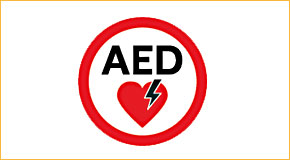 Automatic external defibrillators (AEDs) in public facilities
Automatic external defibrillators (AEDs) in public facilities

As part of our commitment to health and safety in Vancouver, the City and Vancouver Fire and Rescue Services — in partnership with the BC Heart & Stroke Foundation — have installed automatic external defibrillators (AEDs) in many municipal office buildings, community centres, works yards, and libraries.
The first AEDs were placed in City properties by the Gianfranco Giammaria Memorial Society (GGMS), a non-profit society formed in 2008 to raise private funds to purchase and install them.
To date, GGMS has purchased and installed 64 AEDs in recreational facilities in the Lower Mainland, 21 of which are in Vancouver.
Why public access defibrillators?
Cardiac arrest is a medical emergency that can happen to anyone, anywhere.
When the heart suddenly stops pumping blood, the body and brain do not get oxygen. Without immediate treatment, a person's chance of survival drops 10% per minute. Victims lose consciousness, can stop breathing, and may die.
You can use an AED to potentially re-start or correct the heart rhythm of someone who is in cardiac arrest or having a heart attack, even if you have no first-aid training.
AEDs are easy and safe for anyone to use
AEDs automatically read and analyze the heart's electrical rhythm, and determine whether or not a shock is required. In circumstances when it does emit a shock, it can potentially return the heart to its normal rhythm.
It is virtually impossible to make a medical situation worse by using the AED. They are also perfectly safe to use. The electricity is transmitted through the patient's chest between two self-adhesive electrodes, so provided you are not touching the patient when the shock is administered, there is no danger that you will be shocked. You cannot shock anyone else by accident, either.
They are easy to use, and do not require any kind of training (though we always recommend that you take some form of CPR or first-aid training to better equip you to handle medical emergencies).
Steps to using an AED
If you see someone in cardiac arrest (or even think they are in cardiac arrest), take these simple steps:
1. Phone 9-1-1 (or have someone phone for you)
By yourself? Phone 9-1-1 first, then check on the person. Stay on the line, answer the 9-1-1 operator's questions, and follow their directions.
2. Get the AED (or have someone retrieve it)
By yourself and the AED is nearby? Get it first, then check on the person.
3. Turn on the AED and follow the instructions
The AED contains step-by-step audio instructions that will walk you through the entire process. Remember, you do not need any first-aid training to operate the AED, and it will only administer a shock if it is necessary.
